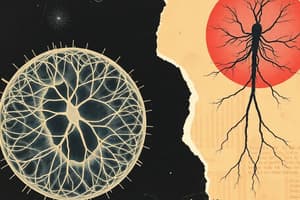Podcast
Questions and Answers
Explain the process of polymerization for microfilaments.
Explain the process of polymerization for microfilaments.
Actin monomers (G-actin) add to the growing end of a filament (F-actin) to form microfilaments. This process is regulated by actin-binding proteins (ABPs) like profilin and cofilin.
What proteins control actin's interaction with myosin?
What proteins control actin's interaction with myosin?
Tropomyosin and troponin control actin's interaction with myosin.
How are microtubules formed and what regulates their assembly?
How are microtubules formed and what regulates their assembly?
Microtubules are formed by tubulin heterodimers, and their assembly is regulated by microtubule-associated proteins (MAPs), GTP hydrolysis for stability, and motor proteins like dynein and kinesin facilitating intracellular transport.
What is the structure of intermediate filaments, and how is their assembly regulated?
What is the structure of intermediate filaments, and how is their assembly regulated?
What are the differences in composition between microfilaments, microtubules, and intermediate filaments?
What are the differences in composition between microfilaments, microtubules, and intermediate filaments?
What pivotal role do microtubules play in cell division?
What pivotal role do microtubules play in cell division?
What contribution do microfilaments make to cell division?
What contribution do microfilaments make to cell division?
In contrast, how do intermediate filaments provide support during cell division?
In contrast, how do intermediate filaments provide support during cell division?
Name two actin-binding proteins (ABPs) that regulate the polymerization of microfilaments.
Name two actin-binding proteins (ABPs) that regulate the polymerization of microfilaments.
What type of proteins regulate actin's interaction with myosin?
What type of proteins regulate actin's interaction with myosin?
What proteins facilitate intracellular transport in relation to microtubules?
What proteins facilitate intracellular transport in relation to microtubules?
Why is the assembly of intermediate filaments considered less dynamic compared to microfilaments and microtubules?
Why is the assembly of intermediate filaments considered less dynamic compared to microfilaments and microtubules?
In the context of cellular structure and support, what are the primary components of microfilaments, and what roles do they play in individual cells and tissues?
In the context of cellular structure and support, what are the primary components of microfilaments, and what roles do they play in individual cells and tissues?
Describe the formation and functions of microtubules at the cellular level and in tissues.
Describe the formation and functions of microtubules at the cellular level and in tissues.
What are intermediate filaments composed of, and how do they provide structural stability to individual cells and tissues subjected to mechanical stress?
What are intermediate filaments composed of, and how do they provide structural stability to individual cells and tissues subjected to mechanical stress?
What are the main components of the extracellular matrix (ECM), and how does the ECM influence cellular behavior?
What are the main components of the extracellular matrix (ECM), and how does the ECM influence cellular behavior?
What role do integrins play in cell-ECM interactions, and how do these interactions influence cellular activities?
What role do integrins play in cell-ECM interactions, and how do these interactions influence cellular activities?
How do focal adhesions contribute to cellular signaling and what pathways do they activate?
How do focal adhesions contribute to cellular signaling and what pathways do they activate?
What are the downstream targets of kinases activated by integrin engagement, and how do they influence cellular processes?
What are the downstream targets of kinases activated by integrin engagement, and how do they influence cellular processes?
How do integrin-mediated interactions with the ECM dynamically regulate cell migration, and what role do integrins play in the process?
How do integrin-mediated interactions with the ECM dynamically regulate cell migration, and what role do integrins play in the process?
What role does the ECM play in influencing the fate decisions of stem cells, and how does integrin-mediated signaling contribute to this process?
What role does the ECM play in influencing the fate decisions of stem cells, and how does integrin-mediated signaling contribute to this process?
How do ECM signaling pathways impact gene expression, and which transcription factors are involved in this regulation?
How do ECM signaling pathways impact gene expression, and which transcription factors are involved in this regulation?
What are the cellular behaviors involved in tissue formation, and how do cell-ECM interactions contribute to tissue homeostasis?
What are the cellular behaviors involved in tissue formation, and how do cell-ECM interactions contribute to tissue homeostasis?
How does the ECM influence the differentiation of stem cells into specific cell types, and what role do integrins play in this process?
How does the ECM influence the differentiation of stem cells into specific cell types, and what role do integrins play in this process?



